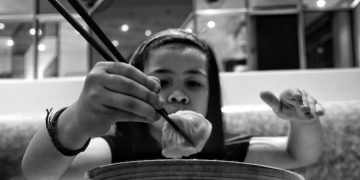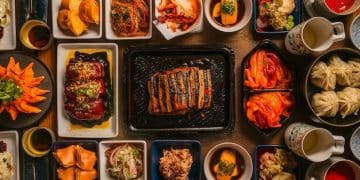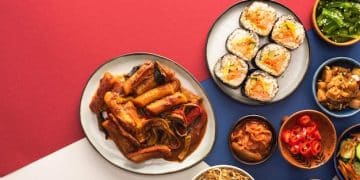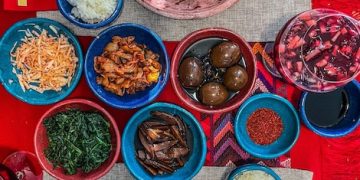Japanese Drama Food: Recreate Delicious Dishes at Home
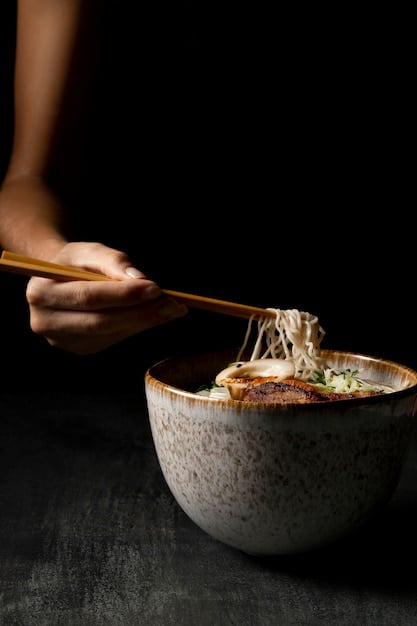
Advertisements
Japanese drama food offers a delectable glimpse into Japanese culture, inspiring viewers to recreate iconic dishes at home and immerse themselves in the flavors of their favorite shows.
Have you ever watched a Japanese drama and felt a craving for the delicious food featured on screen? Japanese drama food is more than just a visual treat; it’s a cultural experience that you can recreate in your own kitchen.
Anúncios
Bringing Japanese Drama Food to Your Kitchen
Japanese dramas, or “doramas,” are not just entertaining; they’re a window into Japanese culture, and food plays a starring role. From comforting bowls of ramen to intricately designed bento boxes, these dishes often become as iconic as the characters themselves. Let’s explore how to bring these culinary delights into your home.
Understanding the Appeal of Dorama Food
Food in Japanese dramas is carefully curated to evoke emotion and enhance the storytelling. A simple bowl of rice can represent comfort, love, or even longing. By understanding this, you can appreciate and recreate these dishes with a deeper connection.
Anúncios
- Visual Appeal: Dorama food is always presented beautifully, emphasizing aesthetics as much as taste.
- Cultural Significance: Each dish carries cultural weight, reflecting traditions and customs.
- Emotional Connection: Food scenes often highlight character relationships and emotional states.
The joy of recreating these dishes lies in not just tasting the food but also experiencing a slice of Japanese culture. Imagine preparing a bento box just like the one your favorite character packs for lunch or slurping down a bowl of ramen during a cozy night in.
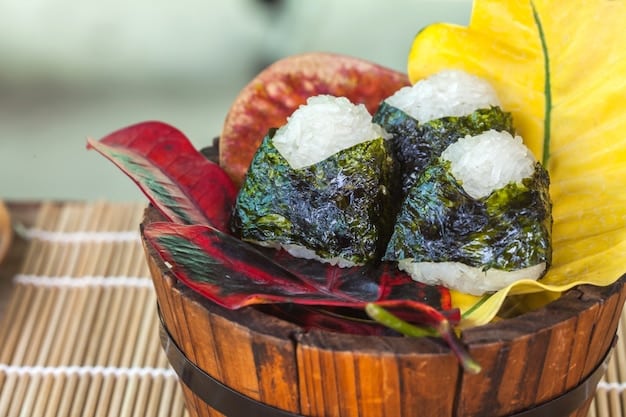
Iconic Dishes from Your Favorite Japanese Dramas
Many dishes have become synonymous with Japanese dramas. These aren’t just meals; they’re cultural symbols that evoke specific feelings and memories for viewers. Here are some of the most iconic ones that you can recreate.
Ramen: The Comfort Food Staple
Ramen is perhaps the most frequently featured dish in doramas. It represents warmth, comfort, and is often enjoyed during pivotal moments in a character’s journey. Each region in Japan has its own unique ramen style, so there’s a world of flavors to explore.
- Tonkotsu Ramen: Known for its rich, creamy pork bone broth.
- Shoyu Ramen: Made with a soy sauce-based broth, typically lighter and clearer.
- Miso Ramen: Features a flavorful miso-based broth, often topped with corn and butter.
Onigiri: The Portable Powerhouse
Onigiri, or rice balls, are another dorama staple, representing convenience and care. They are often seen in bento boxes or as a quick snack. The simple yet versatile nature of onigiri makes it a perfect dish to customize.
- Tuna Mayo Onigiri: A classic filling loved by many.
- Umeboshi Onigiri: Filled with pickled plum, offering a tangy and refreshing taste.
- Salmon Onigiri: Flaked salmon mixed with rice, a nutritious and tasty option.
Bento Boxes: Art in a Box
Bento boxes are a true reflection of Japanese culinary artistry. These meticulously arranged lunch boxes aren’t just about sustenance; they’re about showing care and attention to detail. Doramas often feature elaborate bento boxes that showcase this tradition.
- Kyaraben: Character bento, where food is shaped into popular characters.
- Makunouchi Bento: A classic bento with a variety of dishes, including rice, fish, and vegetables.
- Shokado Bento: A high-end bento served in a divided box, often used for special occasions.
These iconic dishes are more than just food; they’re experiences that connect you to the stories and characters you love. Recreating them at home is a way to deepen your appreciation for Japanese culture and cuisine.
Essential Ingredients for Japanese Drama Food
Before you start cooking, it’s essential to gather the right ingredients. Many Japanese dishes rely on specific flavors and textures that are unique to Japanese cuisine. Knowing where to find these ingredients and how to use them will greatly enhance your cooking experience.
Soy Sauce (Shoyu)
Soy sauce is a cornerstone of Japanese cooking. It’s used in marinades, sauces, and as a condiment. There are different types of **soy sauce**, each with its own flavor profile.
- Koikuchi Shoyu: The most common type, used for general cooking.
- Usukuchi Shoyu: Lighter in color and saltier, often used to preserve the color of ingredients.
- Tamari Shoyu: A gluten-free option, with a richer and more umami flavor.
Miso Paste
Miso paste is fermented soybean paste that adds depth and umami to many dishes. It’s a key ingredient in miso soup, marinades, and sauces. Different types of miso offer varying degrees of sweetness and saltiness.
- Shiro Miso: White miso, mild and slightly sweet.
- Aka Miso: Red miso, stronger and more savory.
- Awase Miso: A blend of white and red miso, offering a balanced flavor.
Dashi
Dashi is a fundamental broth in Japanese cuisine. It’s made from kombu (dried kelp) and katsuobushi (dried bonito flakes) and forms the base for many soups, sauces, and stews. Dashi provides a subtle yet essential umami flavor.
- Kombu Dashi: Made from kombu, offering a vegetarian option.
- Katsuo Dashi: Made from katsuobushi, providing a richer and more complex flavor.
- Awase Dashi: A combination of kombu and katsuobushi, offering a balanced umami flavor.
Other Key Ingredients
Other essential ingredients include mirin (sweet rice wine), sake (rice wine), nori seaweed, rice vinegar, and various types of Japanese noodles. Having these on hand will allow you to recreate a wide range of dorama dishes.
By stocking your pantry with these essential ingredients, you’ll be well-equipped to embark on your journey of recreating Japanese drama food at home.
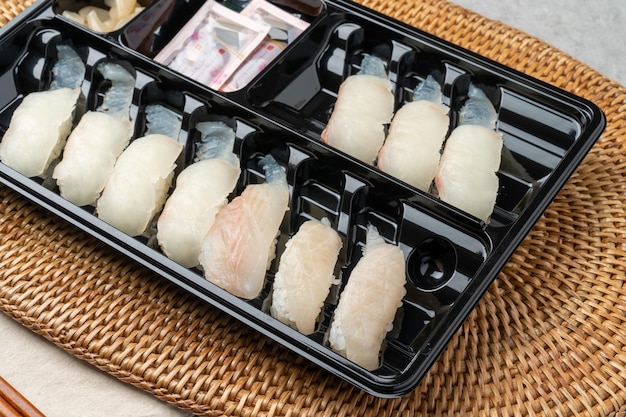
Step-by-Step Guide to Recreating Specific Dishes
Now that you know the iconic dishes and essential ingredients, let’s dive into specific recipes. Here’s a step-by-step guide to recreating some popular dorama dishes in your own kitchen, making your culinary journey as authentic as possible.
Making Tonkotsu Ramen
Tonkotsu Ramen, with its rich and creamy broth, is a labor of love but well worth the effort. Here’s how to make it:
- Prepare the Broth: Simmer pork bones for several hours to extract the collagen and create a creamy broth.
- Prepare the Tare: Combine soy sauce, sake, mirin, and dashi to create the flavor base.
- Cook the Noodles: Use fresh ramen noodles and cook them al dente.
- Assemble the Ramen: Combine the broth, tare, noodles, and toppings like chashu pork, soft-boiled egg, and seaweed.
Creating Tuna Mayo Onigiri
Tuna Mayo Onigiri is a simple yet satisfying snack. Here’s a quick guide:
- Prepare the Rice: Cook Japanese short-grain rice and let it cool slightly.
- Mix the Filling: Combine canned tuna, mayonnaise, and a pinch of salt.
- Shape the Onigiri: Wet your hands, grab a portion of rice, and make a well in the center. Fill it with the tuna mayo mixture.
- Form the Rice Ball: Shape the rice into a triangle or ball and wrap it with a strip of nori seaweed.
Assembling a Basic Bento Box
A basic bento box is a perfect way to enjoy a variety of flavors and textures. Here’s how to put one together:
- Choose a Bento Box: Select a bento box with compartments to keep the food separate.
- Prepare the Rice: Fill one compartment with cooked Japanese rice.
- Add Protein: Include protein options like grilled fish, teriyaki chicken, or tamagoyaki (rolled omelette).
- Include Vegetables: Add colorful vegetables like steamed broccoli, edamame, or pickled vegetables.
- Arrange Neatly: Arrange the food neatly and attractively in the compartments.
With these step-by-step guides, you can start recreating popular dorama dishes and enjoy a taste of Japanese culture at home. Don’t be afraid to experiment with flavors and toppings to create your own unique versions.
Tips for an Authentic Cooking Experience
Recreating Japanese drama food is not just about following recipes; it’s about immersing yourself in the culture and traditions behind the dishes. Here are some tips to enhance your cooking experience and make it as authentic as possible.
Use High-Quality Ingredients
The quality of your ingredients can significantly impact the taste of your dishes. Opt for fresh, high-quality ingredients whenever possible. Look for authentic Japanese brands for soy sauce, miso, and other essential items.
Embrace the Art of Presentation
Presentation is a key aspect of Japanese cuisine. Pay attention to how your food looks, and take the time to arrange it beautifully. Use colorful and contrasting ingredients to create visually appealing dishes. Small details like garnishes and carefully placed toppings can make a big difference.
Understand the Cultural Context
Learning about the cultural context behind the dishes can deepen your appreciation and understanding. Research the history and traditions associated with each dish, and consider how it’s typically enjoyed in Japan. This will not only enhance your cooking experience but also connect you more closely to Japanese culture.
Engage Your Senses
Cooking is a sensory experience. Pay attention to the aromas, textures, and sounds as you prepare your dishes. This will help you to appreciate the process and create more flavorful and authentic meals. Don’t rush through the cooking process; take your time and savor each step.
- Aroma: Appreciate the fragrant smells of dashi, miso, and soy sauce.
- Texture: Notice the varying textures of rice, noodles, and vegetables.
- Sound: Listen to the gentle simmering of broth and the sizzle of ingredients in the pan.
By following these tips, you can elevate your cooking experience and create dishes that are not only delicious but also deeply rooted in Japanese culture. Enjoy the journey of exploration and discovery as you bring the flavors of Japanese dramas into your home.
Health Benefits of Japanese Drama Food
Beyond the delightful flavors and cultural immersion, many Japanese dishes featured in dramas offer significant health benefits. Embracing these culinary traditions can contribute to a balanced and nutritious diet, reflecting Japan’s reputation for longevity and wellness.
Nutrient-Rich Ingredients
Japanese cuisine often incorporates a variety of nutrient-rich ingredients, such as seaweed, fish, soy products, and vegetables. These foods are packed with vitamins, minerals, and antioxidants that support overall health.
Balanced Macronutrient Profile
Many Japanese dishes feature a balanced macronutrient profile, with a good mix of carbohydrates, proteins, and healthy fats. This balance is essential for maintaining energy levels, supporting muscle growth, and promoting overall well-being.
Low in Processed Foods
Traditional Japanese cooking emphasizes the use of fresh, whole foods and minimizes processed ingredients. This can help reduce your intake of unhealthy additives, preservatives, and refined sugars, promoting a healthier diet.
Portion Control and Mindful Eating
Japanese dining culture often encourages portion control and mindful eating. Serving dishes in smaller bowls and plates can help you be more aware of your hunger cues and avoid overeating.
- Smaller Portions: Encourages moderation and helps prevent overconsumption.
- Mindful Eating: Promotes awareness and appreciation of the food’s flavors and textures.
By incorporating Japanese drama food into your diet, you can enjoy a wide range of health benefits while savoring delicious and culturally rich meals. Embrace the tradition and savor the flavors of Japan.
| Key Point | Brief Description |
|---|---|
| 🍜 Iconic Dishes | Learn to recreate famous ramen, onigiri, and bento seen in dramas. |
| 🥢 Essential Ingredients | Stock up on soy sauce, miso, and dashi to boost your cooking. |
| 🍱 Authentic Experience | Focus on quality, presentation, and cultural meaning for greater enjoyment. |
| 💪 Health Benefits | Enjoy healthful food that promote well-being via a nutrient-rich ingredient. |
Frequently Asked Questions (FAQ)
Japanese drama food refers to the delectable dishes featured in Japanese dramas (doramas), which often become iconic and inspire viewers to recreate them at home, connecting them with the cultural and emotional context of their favorite shows.
Authentic Japanese ingredients can be found at Asian supermarkets, specialty grocery stores, or online retailers. Look for brands that are specifically Japanese for the best quality in soy sauce, miso, and other essentials.
Improve the presentation by using colorful and contrasting ingredients, arranging the food neatly in bowls and bento boxes, and adding small garnishes. The visual appeal is a key aspect of Japanese cuisine and enhances the overall experience.
Yes, many Japanese dishes are packed with nutrients, low in processed foods, and promote balanced macronutrient profiles. Ingredients like seaweed, fish, and soy products are rich in vitamins, minerals, and antioxidants, contributing to a healthy diet.
Absolutely! Feel free to customize the recipes to suit your dietary needs and preferences. Substitute ingredients based on availability or personal tastes. For example, use gluten-free soy sauce and tofu instead of meat if you are vegetarians.
Conclusion
Recreating **Japanese drama food** at home offers a unique way to connect with Japanese culture and enjoy delicious, healthful meals. From mastering iconic dishes to understanding the cultural context, the journey is both rewarding and enriching. So, grab your chopsticks and embark on this culinary adventure!
